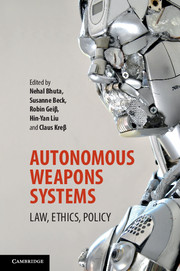Book contents
- Frontmatter
- Contents
- List of contributors
- Acknowledgements
- PART I Introduction
- PART II Meanings of autonomy and human cognition under automation
- PART III Autonomous weapons systems and human dignity
- PART IV Risk, transparency and legal compliance in the regulation of autonomous weapons systems
- 7 Judgment, liability and the risks of riskless warfare
- 8 Autonomous weapons systems and transparency: towards an international dialogue
- 9 A human touch: autonomous weapons, DoD Directive 3000.09 and the interpretation of ‘appropriate levels of human judgment over the use of force’
- 10 Autonomous weapons systems: managing the inevitability of ‘taking the man out of the loop’
- PART V New frameworks for collective responsibility
- PART VI New frameworks for individual responsibility
- PART VII Conclusion
- Index
10 - Autonomous weapons systems: managing the inevitability of ‘taking the man out of the loop’
from PART IV - Risk, transparency and legal compliance in the regulation of autonomous weapons systems
Published online by Cambridge University Press: 05 August 2016
- Frontmatter
- Contents
- List of contributors
- Acknowledgements
- PART I Introduction
- PART II Meanings of autonomy and human cognition under automation
- PART III Autonomous weapons systems and human dignity
- PART IV Risk, transparency and legal compliance in the regulation of autonomous weapons systems
- 7 Judgment, liability and the risks of riskless warfare
- 8 Autonomous weapons systems and transparency: towards an international dialogue
- 9 A human touch: autonomous weapons, DoD Directive 3000.09 and the interpretation of ‘appropriate levels of human judgment over the use of force’
- 10 Autonomous weapons systems: managing the inevitability of ‘taking the man out of the loop’
- PART V New frameworks for collective responsibility
- PART VI New frameworks for individual responsibility
- PART VII Conclusion
- Index
Summary
Introduction
War and technological development have been indelibly linked for centuries. Military leaders will constantly seek both the means (weapons) and the methods (tactics) of warfare to maximize their full-spectrum dominance over their adversaries. When assessing the value of emerging weapons technologies, mitigating risk to friendly forces has always been perceived as a key benefit. This aspect of weapons technology is increasingly valued in an era of all volunteer forces and a general perception among strategic decision makers that the public is generally averse to friendly casualties, even when force is employed to achieve vital national or international objectives. At the operational level, all commanders seek to husband resources while achieving precision effects, and, therefore, technologies that facilitate producing such effects with limited risk to friendly forces will be highly coveted.
Willingness to accept mortal risk in pursuit of important objectives is, of course, a core ethos of a professional military. One of the greatest burdens of military command is the authority and responsibility to send subordinates into harm's way to achieve such goals, knowing full well that many may lose their lives or be seriously injured while obeying these orders. Issuing such orders and subjecting subordinates to mortal risk is, however, a key aspect of military command. But when technology can empower a commander to accomplish tactical and operational objectives with little or no risk to friendly forces, it should be self-evident why commanders at all levels covet such options.
However, there have always been inherent limits on the extent to which technology may be used as an effective substitute for human action. To date, these limits have generally focused on the ability to control the effects of a weapon system once employed. Thus, the law prohibits use of such weapons as chemicals and other poison gas, air-delivered incendiaries in populated areas and any other weapons that cannot be directed with any reasonable certainty to strike an intended target. Autonomous weapons – weapons with the capacity to utilize artificial intelligence to replicate human cognitive reasoning – present an entirely new dilemma to the regulation of armed conflict.
Information
- Type
- Chapter
- Information
- Autonomous Weapons SystemsLaw, Ethics, Policy, pp. 209 - 242Publisher: Cambridge University PressPrint publication year: 2016
Accessibility standard: Unknown
Why this information is here
This section outlines the accessibility features of this content - including support for screen readers, full keyboard navigation and high-contrast display options. This may not be relevant for you.Accessibility Information
- 5
- Cited by
